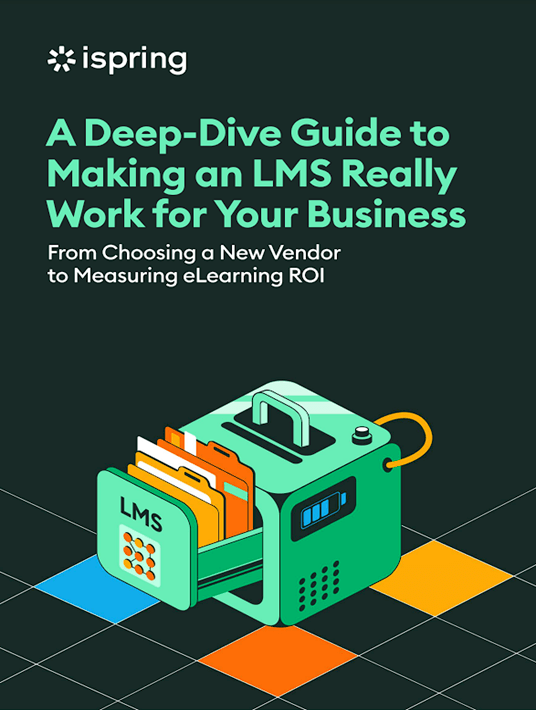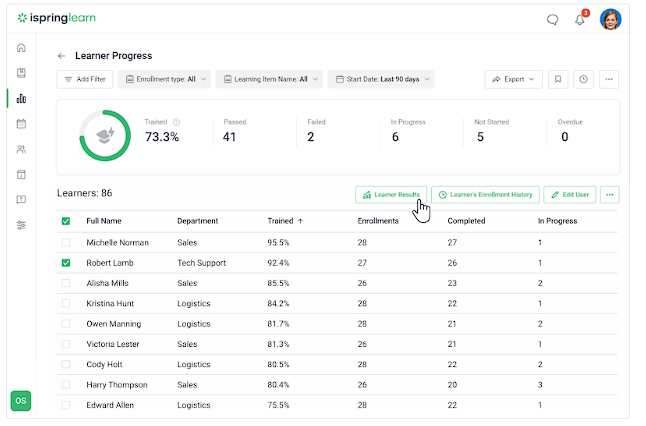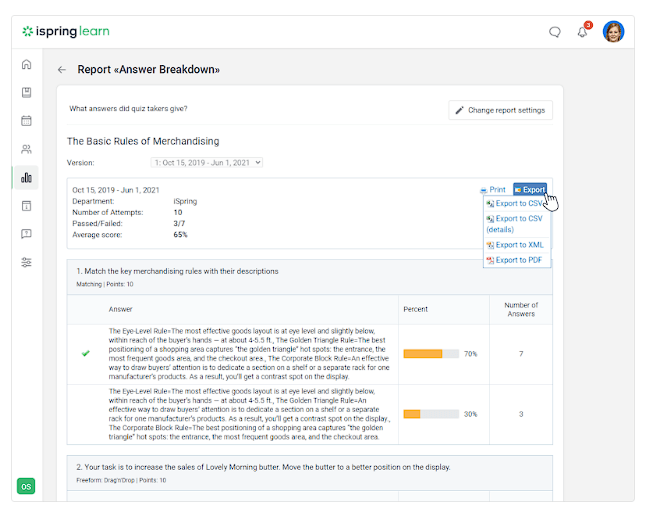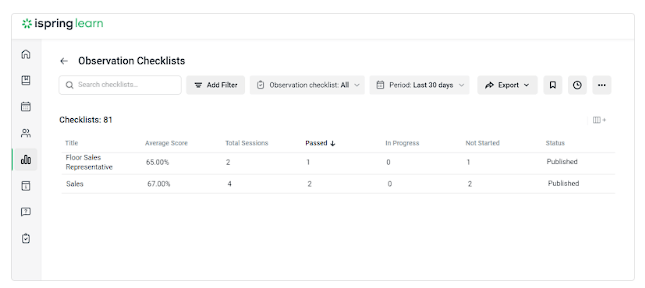Tracking Training Effectiveness: Key Metrics And Reports
To evaluate training effectiveness, you need specific metrics that are relevant to your goals. The main training metrics should include:
- Completion rate. The percentage of learners who finish the course.
- Pass or fail rate. This applies to assessments and their successful completion.
- Scoring. It helps you estimate learners’ performance and identify skill gaps.
- Learner satisfaction. Feedback from learners about the course’s content and format.
- Time to competency. The time it takes for learners to reach the desired skill level.
- Post-training performance. This indicates how employee performance has improved (e.g., increased sales, improved customer feedback).
- Return On Investment (ROI). The financial benefit gained from the training compared to its cost.

eBook Release
A Deep-Dive Guide To Making An LMS Really Work For Your Business
Whether you’re new to LMSs or want to get more out of your current platform, this guide will help you make your investment worthwhile.
Pro-tip: Start by identifying the metrics that serve as key indicators of training success in your company. For example, track the completion rate to ensure that most employees complete their courses, aligning with the business goal of comprehensive employee development. Or, monitor performance improvement by tracking increased sales, which directly ties to revenue growth goals.
Once you’ve established the relevant training metrics, move on to measuring training effectiveness. You can do this using different methods and models. One of the most widely used models in employee training assessment is the Kirkpatrick Model. It allows you to assess a training program and its value to the business across four levels:
![]()
Reaction
Measure learners’ immediate satisfaction and engagement with the training program. The evaluation is based on trainee feedback.
How To Measure With An LMS
An LMS is the perfect tool for conducting surveys and collecting employee feedback. You can create and track questionnaires directly in the system, eliminating the need to deal with printed paper forms.
![]()
Examples of employee satisfaction survey questions:
- How satisfied are you with the training content provided?
- Was the training material easy to understand and follow?
- Do you feel more confident in your job after completing the training?
- How likely are you to recommend this training to a colleague?
- What improvements would you suggest for future training sessions?
Based on survey results, you can:
- Identify areas for improvement.
- Adjust training content and methods.
- Ensure that future training sessions meet the needs and expectations of your employees better.
Learning
Assess the increase in knowledge or skills through tests and evaluations conducted during or immediately after the training.
How To Measure With An LMS
Use the LMS assessment progress and results reports. Platforms like iSpring Learn offer a wide range of reports to monitor employee achievements, including:
Progress And Completion Rates
See how learners are advancing through their courses and how many have successfully completed them.

Assessment Scores
Scores indicate how well learners have understood and retained the training material. They reflect the effectiveness of the training program.
![]()
Assessment Attempts And Answer Breakdown
See the number of times trainees take assessments and their performance on individual questions. You’ll get insights into areas where learners might be struggling and can identify specific topics that may need further clarification or repeated training.

Behavior
Measure the extent to which trainees apply the knowledge and skills gained during training to their job roles. You’ll see how training has influenced their performance and behavior in the workplace.
How To Measure With An LMS
Use the following LMS capabilities to see how effectively employees are applying their training on the job:
On-The-Job Training Observation Checklists
In iSpring Learn, you can run on-the-job training modules as part of your training programs. The LMS provides Observation Checklist reports, with which you can track the results of employees’ training sessions. This is a solid way to ensure that practical skills are being applied correctly in real-world scenarios and to identify any areas that need further improvement.

Performance Reviews
You can also collect feedback in a 360-degree survey format with iSpring Learn. Gather anonymous data across various factors of employees’ performance from their clients and coworkers, from subordinates to management. This way, you can identify the employee’s strengths, areas for improvement, and suitability for their current roles.

Additionally, you can use:
- Self-assessment questionnaires
- Customer surveys, comments, or complaints
- Data from work processes (call resolution time, error rates, etc.)
Results
Finally, assess the effect that training is having on your business performance. Once again, this ties back to the goals you had in mind when launching training with an LMS.
Business results usually include:
- Increased sales. Measure the boost in sales revenue after your learners complete sales training programs.
- Improved customer satisfaction. Track customer feedback scores to see if they improve after training.
- Higher productivity rates. Assess an increase in output or efficiency.
- Reduced error rates. Monitor the reduction in errors or defects in production.
- Employee retention. Evaluate the impact of training on employee satisfaction and retention rates by comparing turnover before and after training initiatives.
- Lower training costs. Measure the reduction in training expenses by comparing traditional training methods with the cost-efficiency of using an LMS.
Keeping track of these results is necessary to demonstrate the value of your training programs, make data-driven decisions for future training initiatives, and calculate the ROI of the LMS.
Download A Deep-Dive Guide To Making An LMS Really Work For Your Business today to navigate the entire process of effective Learning Management System implementation and use.
